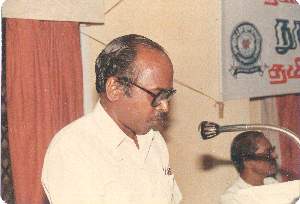
Home | Biodata | Biography | Photo Gallery | Publications | Tributes
Tamil Studies

 |
Home | Biodata | Biography | Photo Gallery | Publications | Tributes Tamil Studies |
 |
For the Tamils of the pre-British period, a scholar was one who was well versed in the arts and sciences addressing the needs of the minds as well as of the bodies of the members of her/his community. (S)he acquired expertise not only in language, and mathematics, but also in medicine and martial arts. Such a scholar is known as aacaan (from aacu, basis, standard + aan , masculine suffix; he who can be regarded as the 'standard', he who sets standards) and a few survivors of this rare breed may still be found in Kerala and Kanniyakumari district. In fact Prof. Siromoney's grand uncle, Abraham Pandither (1859-1919) himself (who was teacher, musician, medical doctor, fortune teller all at the same time) may be placed in this category. Though Prof. Siromoney was a specialist in Mathematics and a 'product' of a system of education modelled after that of the British that favours specialisation rather than versatility, he defied, in all possible ways, the norm of the scholar-specialist. If Prof. Siromoney were born a few hundred years earlier, to us, he would have been Aacaan Siromoney rather than Professor Siromoney.
Like his aacaan-predecessors, Prof.Siromoney took keen interest in the whole life of his own society. He focussed on the natural environment as well as the culture of his society. If his nature studies are an attempt to understand the former, his culture studies (on texts like Tolkaappiyam, cankam literature, Kamparaamaayanam and several minor works, inscriptions, language, sculpture, archaeology, music, kolam , technology, education, history, electorate and so on) address the latter. In a way it is true that Prof.Siromoney studied only one subject -- the Tamil society. If so, what about his formal expertise in Mathematics, Statistics and Computer Science? These provided the novel tools he required to study his master subject. By applying these new techniques he was not only directing the attention of the academia to his society, but also connecting the past of Tamils (in such writings as 'The History of Tambaram Area', 'Ancient Iron-smelting Site near Tambaram') with their present meaningfully and relevantly. In existential terms this was a kind of 'authentication'. May be he is challenging the academic world to regard the mathematical sciences as means (and not as ends in themselves) to engage with one's society. May be it is a move towards the traditional Tamil type of education which was basically applied (rather than pure/theoretical) in nature.
One of the areas of Tamilology in which Prof. Siromoney has made significant contribution is Tamil musicology. If Abraham Pandither reformulated the discipline in the early 20th century and thereby initiated a virtual renascence in Tamil music and musicology, Prof.Siromoney threw new light on ancient music material ('Some New Light on Stringed Instruments of the Ancient Tamil Country'), provided fresh insights by bringing to bear modern scientific techniques upon the data of the field ('Statistical Aids in Tamil Studies', 'Style as information in Karnatic Music', 'Computer Recognition and Transliteration of Mridangam Mnemonics', 'Machine Recognition of Hand-printed Tamil Musical Notation' and so on), addressed new questions ('A Pallava Musical Instrument'), and opened new avenues for research. His academic forays into sculptures have yielded us not only a fairly good idea of ancient Tamil costumes and jewellery, but also substantial musicological data and clarified isssues in the field. For example, in the light of the sculptural depiction of cakota yaal at Darasuram temple, he proves the earlier accounts that attribute a curved stem to this instrument wrong. Though the chief target here is Vipulanandar's Yaal Nuul (1947, v-vi), there are others like the entry in Tamil Kalaikkalanjiyam (by Vellaivaranar, 1961, viii. 582).
Any one who peruses the writings of this aacaan cannot but be touched by his love for his culture and society. This love never sours into ethnocentrism for the simple reason that his claims and findings are based on hard scientific research.
-Nirmal Selvamony.
Publications